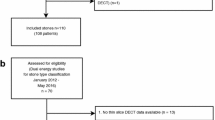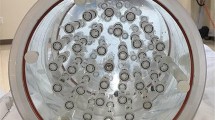Abstract
Objective
To develop a dual-energy CT (DECT) method for differentiating uric acid (UA) from non-UA stones in the presence of iodinated contrast medium.
Methods
Thirty UA and 45 non-UA stones were selected after infra-red spectroscopic analysis and independently placed in a 1.5-ml vial, which was filled first with saline and then with increasing concentrations of iodine. For each condition, tubes were put in a 35-cm water phantom and examined using a dual-source CT system at 100 and 140 kV. Virtual unenhanced images created from CT data sets of the stones in iodine-containing solutions provided position and volume information. This map was used to calculate a CT number ratio to differentiate stone type. A region-growing method was developed to improve the ability to differentiate between UA and non-UA stones with iodinated contrast medium.
Results
The sensitivity for detecting UA stones was 100 % for unenhanced images but fell to 18 % with 20 mgI/ml iodine solution and 0 % for higher concentrations. With region growing, the sensitivity for detecting UA stones was increased to 100 %, 82 %, 57 %, 50 % and 21 % for iodine solutions of 20, 40, 60, 80 and 100 mgI/ml.
Conclusion
The region-growing method improves differentiation of UA from non-UA stones on contrast-enhanced DECT urograms.
Key Points
• Computed tomography is widely used to assess renal tract calculi
• Dual-energy CT can assess stone composition and provide virtual unenhanced images
• However, iodinated contrast medium affects the volume estimation for urinary stones.
• CTR of stones is altered by the surrounding iodine in CT urograms.
• The region-growing method improves the identification of uric acid stones.




Similar content being viewed by others
Abbreviations
- CT:
-
computed tomography
- DECT:
-
dual-energy computed tomography
- UA:
-
uric acid
- CYS:
-
cystine
- COX:
-
calcium oxalate
- APA:
-
calcium hydroxyapatite
- CTR:
-
CT number ratio
References
Smith RC, Rosenfield AT, Choe KA et al (1995) Acute flank pain: comparison of non-contrast-enhanced CT and intravenous urography. Radiology 194:789–794
Fielding JR, Steele G, Fox LA, Heller H, Loughlin KR (1997) Spiral computerized tomography in the evaluation of acute flank pain: a replacement for excretory urography. J Endourol 157:2071–2073
Williams JC, Kim SC, Zarse CA, Mcateer JA, Lingeman JE (2004) Progress in the use of helical CT for imaging urinary calculi. J Endourol 18:937–941
Vrtiska T (2005) Quantitation of stone burden: imaging advances. Urol Res 33:398–402
Demehri S, Kalra MK, Rybicki FJ et al (2011) Quantification of urinary stone volume: attenuation threshold–based CT method—a technical note. Radiology 258:915–922
Nakada SY, Hoff DG, Attai S, Heisey D, Blankenbaker D, Pozniak M (2000) Determination of stone composition by noncontrast spiral computed tomography in the clinical setting. J Urol 55:816–819
Bellin M-F, Renard-Penna R, Conort P et al (2004) Helical CT evaluation of the chemical composition of urinary tract calculi with a discriminant analysis of CT-attenuation values and density. Eur Radiol 14:2134–2140
Lingeman JE, McAteer JA, Gnessin E, Evan AP (2009) Shock wave lithotripsy: advances in technology and technique. Nat Rev Urol 6:660–670
Primak AN, Fletcher JG, Vrtiska TJ et al (2007) Noninvasive differentiation of uric acid versus non-uric acid kidney stones using dual-energy CT. Acad Radiol 14:1441–1447
Grosjean R, Sauer B, Guerra RM et al (2008) Characterization of human renal stones with MDCT: advantage of dual energy and limitations due to respiratory motion. AJR Am J Roentgenol 190:720–728
Thomas C, Patschan O, Ketelsen D et al (2009) Dual-energy CT for the characterization of urinary calculi: in vitro and in vivo evaluation of a low-dose scanning protocol. Eur Radiol 19:1553–1559
Boll DT, Patil NA, Paulson EK et al (2009) Renal stone assessment with dual-energy multidetector CT and advanced postprocessing techniques: improved characterization of renal stone composition—pilot study. Radiology 250:813–820
Hidas G, Eliahou R, Duvdevani M et al (2010) Determination of renal stone composition with dual-energy CT: in vivo analysis and comparison with x-ray diffraction. Radiology 257:394–401
Stolzmann P, Leschka S, Scheffel H et al (2010) Characterization of urinary stones with dual-energy CT: improved differentiation using a tin filter. Invest Radiol 45:1–6
Qu M, Ramirez-Giraldo JC, Leng S et al (2011) Dual-energy dual-source CT with additional spectral filtration can improve the differentiation of non-uric acid renal stones: an ex vivo phantom study. AJR Am J Roentgenol 196:1279–1287
Eiber M, Holzapfel K, Frimberger M et al (2012) Targeted dual-energy single-source CT for characterisation of urinary calculi: experimental and clinical experience. Eur Radiol 22:251–258
Alvarez RE, Macovski A (1976) Energy-selective reconstructions in X-ray computerised tomography. Phys Med Biol 21:733
Kelcz F, Joseph PM, Hilal SK (1979) Noise considerations in dual energy CT scanning. Med Phys 6:418–425
Scheffel H, Stolzmann P, Frauenfelder T et al (2007) Dual-energy contrast-enhanced computed tomography for the detection of urinary stone disease. Invest Radiol 42:823–829
Takahashi N, Hartman RP, Vrtiska TJ et al (2008) Dual-energy CT iodine-subtraction virtual unenhanced technique to detect urinary stones in an iodine-filled collecting system: a phantom study. AJR Am J Roentgenol 190:1169–1173
Takahashi N, Vrtiska TJ, Kawashima A et al (2010) Detectability of urinary stones on virtual nonenhanced images generated at pyelographic-phase dual-energy CT. Radiology 256:184–190
Moon JW, Park BK, Kim CK, Park SY (2011) Evaluation of virtual unenhanced CT obtained from dual-energy CT urography for detecting urinary stones. Br J Radiol. doi:10.1259/bjr/19566194
Qu M, Ramirez-Giraldo JC, Wang J et al (2010) Advanced dual-energy image processing algorithm to improve the discrimination of renal stones in phantoms of large size patients using dual-energy dual-source CT RSNA, Chicago, IL
Acknowledgements
This study was supported by NIH grant nos. DK83007 and DK59933. The authors would like to thank Kristina Nunez for her assistance with manuscript preparation.
Author information
Authors and Affiliations
Corresponding author
Appendix
Appendix
After the stone was segmented from the background soft tissue structures using the commercial virtual unenhanced technique, a binary map of stone position was applied to the CTR image (CTR = CT_low kV/CT_high kV). For each stone, the centre slice along the z direction was used to determine the starting point of the region-growing iterative process (Fig. A1a). First, an internal region was acquired by performing a four-pixel by four-pixel area of erosion on the CTR map of the centre slice. Then, the pixel with the closest CTR value to the average CTR of the internal region was chosen as the starting point (the seed). Starting from the seed, the nearest 26 neighbouring pixels were searched (Fig. A1b) in an iterative process (Fig. A2) to find all pixels that had CTR values within a certain range relative to the mean CTR of the stone. The width of the range is the only parameter to be defined before the iteration. Here 0.2 (± 0.1) was used for all stones at all five iodine concentrations. As shown in Fig. A2, the mean CTR was updated at each iteration and, as more pixels were included, it was expected to approach the true CTR of the stone, with those pixels affected by iodinated contrast medium (far away from the centre) excluded.
Rights and permissions
About this article
Cite this article
Wang, J., Qu, M., Duan, X. et al. Characterisation of urinary stones in the presence of iodinated contrast medium using dual-energy CT: a phantom study. Eur Radiol 22, 2589–2596 (2012). https://doi.org/10.1007/s00330-012-2532-0
Received:
Revised:
Accepted:
Published:
Issue Date:
DOI: https://doi.org/10.1007/s00330-012-2532-0






